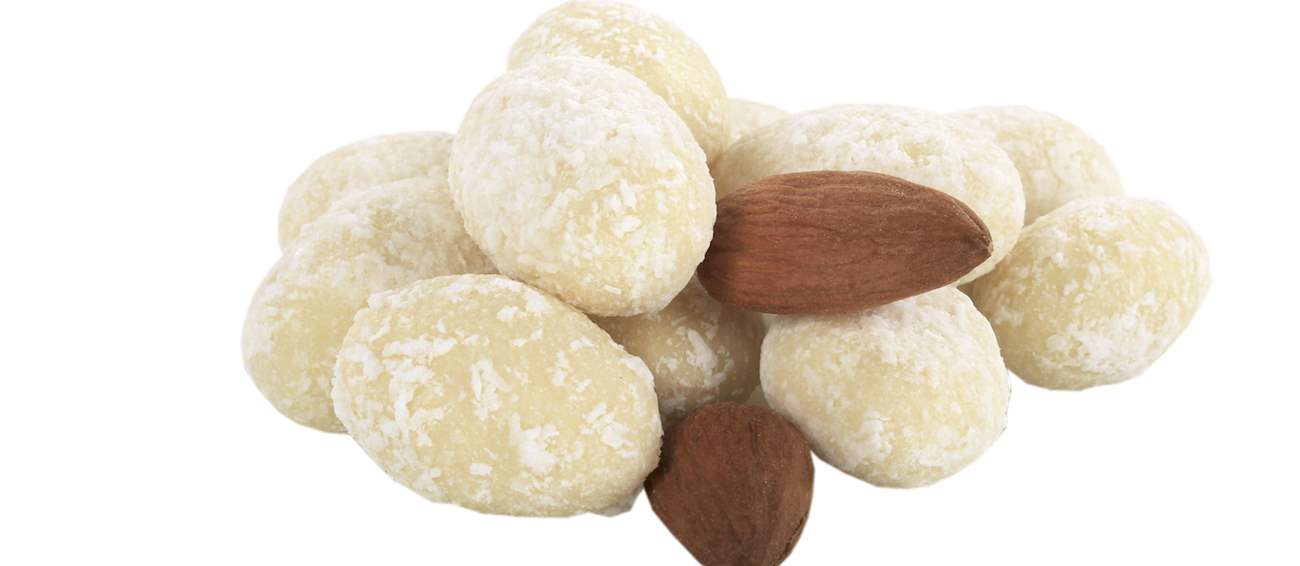Ginnan are Japanese gingko seeds characterized by a pungent smell, soft and sticky texture, and a slightly bitter flavor. They also act as cough suppressants and are highly nutritious. Ginkgo trees can be found throughout Japan and China, and the seeds are usually collected in Autumn, when they fall to the ground.
Although it is not that common to consume them, they are sometimes roasted or used in the preparation of a savory egg pudding known as chawanmushi. One should be careful when consuming ginnan, because it can cause poisoning by MPN if eaten in large quantities (more than five seeds per day).
Koufeta Amygdalou Geroskipou are roasted sugared almonds made in the municipality of Geroskipou according to the traditional family recipe created by Sophocles Athanasios who started making them in 1895. Locally-grown almonds are coated in sugar syrup and have a characteristic rough surface.
The authentic methods of production and knowledge of the Geroskipou producers are crucial for making this delicious treat. The whole coating process must be monitored in order to intervene immediately if the adjustment of the quantity of the syrup or the temperature is required.
Noix de Grenoble are walnuts that are gathered in their shells from the end of September and come from three different varieties in the French departments of Isére, Drôme and Savoie. The ancient Romans brought the walnut trees to France and since it was a highly prized item (they used to pay the rent with walnuts), the trees were very well nurtured and cared for, giving the Grenoble walnuts their unique quality and taste.
The three varieties of these walnuts (franquette, mayette, and parisienne) differ in shape, color and taste, and they are commonly used in onion soups that are served at weddings, pressed for walnut oil, eaten candied, in the form of nougat or jam, in salads, cheeses or used in cakes.
Český kmín are caraway seeds of the "Carum carvi L - fructus" species produced in the Czech Republic on loamy, sandy and clay soils since the first half of the 19th century. The seeds are well-formed and developed, healthy, elongated and slightly bent.
They are bright to dark brown in colour and have a spicy flavour typical of caraway. Their uniqueness is due to the fact that they have a high content of aromatic oil (from 3 to 5 %) and are harvested when they are well matured. Carvone content in the seeds is higher than 50%, with healing and antiseptic properties.
Since the climate of densely forested northwestern district of Lower Austria is ideal for cultivating poppies, each year there are between 200 and 700 hectares used for growing Waldviertler Graumohn, the so-called ''grey gold'' of the Waldviertel region.
The composition of soil found in this region ensures a somewhat slower growth rate, which greatly enhances the quality and quantity of the poppy seeds, and thus provides them with a distinctive, nutty flavor. Apart from the versatile poppy seeds, another widely used product in traditional Austrian cuisine is the Waldviertel poppy seed oil, produced in Ottenschlag.
Châtaigne d'Ardéche are sweet chestnuts of the ancient local varieties of Castanea sativa Miller grown and harvested in the Ardéche, the largest chestnut-producing region in France, with an annual Chestnut Festival and even a Chestnut museum in the medieval town of Joyeuse.
They can be used for making chestnut flour, or may come as fresh unpeeled chestnuts or peeled dry chestnuts. The taste is uniquely sweet, with aromas of pastry, sweet potatoes, honey, onion squash and pain au lait. For dried chestnuts, there are aromas of nuts, almonds, hazelnuts, and cake, sometimes accompanied by a slightly bitter flavor.
Brazil nuts (Bertholletia excelsa) are nutrient-packed nuts coming from the eponymous South American tree. The trees typically produce these nuts only in pristine forests, and despite their name, the most important exporter of Brazil nuts is Bolivia.
The nuts are popular throughout the world and they are nowadays considered a superfood due to numerous health benefits these nuts provide to the average consumer. They improve heart health, help with regulating skin-related problems, stimulate the digestive system, boost the immune system, and improve hormone function.
Noix du Périgord are early or dry walnuts or walnut kernels with a fine texture and a unique taste similar to black walnuts, produced in the French regions of Aveyron, Charente, Corréze, Dordogne, Lot and Lot-et-Garonne, where the walnuts must be grown, shelled and packed.
Early walnuts are fresh and sold in their shells and the nuts are white with a thin skin that can be easily peeled. Dry walnuts are gently dried and less bitter than early walnuts and the walnut kernels are small, light or dark in color and must be minimally 8 mm in size.
TasteAtlas food rankings are based on the ratings of the TasteAtlas audience, with a series of mechanisms that recognize real users and that ignore bot, nationalist or local patriotic ratings, and give additional value to the ratings of users that the system recognizes as knowledgeable. For the “8 Worst Rated Nuts and Seeds in the World” list until March 26, 2025, 1,993 ratings were recorded, of which 759 were recognized by the system as legitimate. TasteAtlas Rankings should not be seen as the final global conclusion about food. Their purpose is to promote excellent local foods, instill pride in traditional dishes, and arouse curiosity about dishes you haven’t tried.






